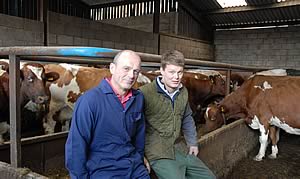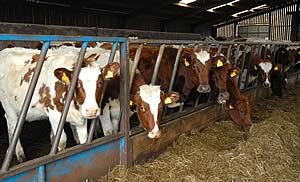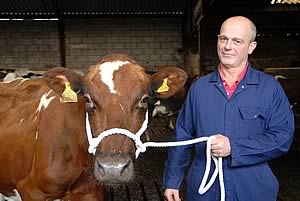 |
|||||||||
|
||||||||||||||||||||
|
|
The Future is Bright for Ayrshires at Sunny Bank When David Galbraith took on Sunny Bank Farm, Grayrigg, near Kendal in 1981 he bought some Ayrshire cows because they were £100 a head cheaper than black and whites.
He quickly found that they suited the farm and they were easy to manage by himself and his wife Carol. The farm gradually increased in size from the original 89 rented acres and milking 20 cows to today’s 510 acres, all but 70 acres of which is in the Less Favoured Area, with the couple having taken the opportunity to buy 330 acres and rent the remainder. All the farm, which is very wet land, is in higher level Countryside Stewardship and none of its acreage is ploughable. It includes 100 acres of moorland running up to 1,200ft with the farm steading standing at 600ft. Herd numbers have now been pushed up to 100 pedigree Ayrshire cows which were graded up from the original females and, should the Galbraith’s son Craig, who has just achieved a degree in engineering, decide to return home to farm, numbers can be increased again if the current 600 principally Lleyn ewe flock is reduced in size. “I had never had anything to do with Ayrshires and when we started farming on our own it was a question of buying anything that was cheap but we found that the breed suits the farm. If Holsteins were our choice then I doubt we would be dairy farming,” said David.
“The future for Ayrshires is looking better than it has for some time. There is renewed interest in the breed. One good thing that resulted from foot and mouth was that people realised there were other breeds than the Holstein and a lot of people took it as a chance to change. There is also renewed interest in cross-breeding but to do that you have to have the pure bred animal.” Herd replacements are bred on the farm and Canadian Ayrshire, Swedish Red and some Holstein bloodlines are used with the aim of producing a cow which is no more than 25 per cent Holstein, just enough to add dairyness. “The cows we are milking are not as big as the Holstein and they cope better with the type of land which is harder grazing,” said David. “We also get better quality milk and we don’t seem to have as many problems. The cows are easy to look after, which is important as it is me and Carol running the farm with some help from Craig. “Last winter I only trimmed eight cows’ feet which is amazing considering the length of our winters. This year the cows were housed from mid-September with turnout at the beginning of May.” The herd which to build up numbers currently includes 25per cent heifers has an average yield to the end of September of just over 6,500 litres at 4.12 per cent butterfat and 3.4 per cent protein which is currently earning 27p per litre from First Milk. Last year the heifers averaged more than the cows, proof of the success of the breeding programme. David says the higher constituent value of the milk helps make up for the reduction in yield compared with Holsteins. The cows also last longer with between 15 and 20 replacements required each year now numbers have been reached and the oldest cows still milking in their ninth or tenth lactations.
Fertility is also good with a calving index of 390. Heifers are calved at 30 to 36 months old to allow them to grow with a view to selling surplus heifers. Heifers are put to the Angus bull with up to 40 of the lower yielding cows crossed with the British Blue. All inseminations are by DIY AI. Pedigree sires are selected through Edward Evans, field services manager with Cattle Services, the commercial arm of the Ayrshire Cattle Society, of which David is a former council member. Recent sires used include McCornick Nelson, a pure Ayrshire and Brieryside Jubilant Scot a half Ayrshire half Holstein. Their daughters which are now on the ground will be put back to a pure Ayrshire bull. Twenty six of their heifer daughters are milking in the herd and averaged 6,504 litres in the 12 months to September. They will help David and Carol achieve their target herd average of 7,500 litres a cow. This year cows are calving to Changue Tryst and Lagace Modem and cows are being put back in calf to Canadian sire Yellowbriar Journalist, a pure Ayrshire, Hunnington BBK Easlad, a pure Ayrshire, and Twemlow Major Threat which is a half Holstein and half Ayrshire, both of which are UK bred bulls. “The most important thing is to breed a cow that will suit our farm. The gene pool in the UK has been improving thanks to the work of Cattle Services and the society and to the young bull testing scheme which I try to use some straws from.” Successful cow families to emerge are the Marys which originate from a cow bought for 400gns from Alan Coutts herd in Knutsford which produced numerous daughters – one of her heifer calves, born in 1999, has completed her sixth lacatation having produced a calf every year. In her last lactation she gave 9,247 litres at 3.81 butterfat and 3.25 protein and has yielded more than 50,000 tonnes of milk in her lifetime. She is the dam of one of the show heifers.
The Galbraiths show at the Westmorland County Show and Grayrigg Show and at this year’s Westmorland they took three animals and got three second prizes and a second and a fourth in the pairs. One of the cows shown, Sunny Bank Finery which is 50 per cent Holstein, has just calved her fourth to the pure Ayrshire, and in three lactations has yielded 25,304 litres The herd was also second in the annual Cumberland Ayrshire Breeders’ Club herds competition class for heifers by one sire which was McCornick Nelson. The herd is calved from mid July to the end of March to make the most of milk payments. They are fed through a diet feeder a base ration comprising grass silage, brewers grains and caustic treated wheat up to 17 litres and an I’Ansons concentrate on the advice of adviser Matthew Sharpe is fed up to a maximum of 3kg through the parlour installed five years ago and increased further according to yield through out of parlour feeders installed 20 years ago. Costings for August 2008 were 0.34kg of concentrate per litre with a margin over concentrate of 19.4p per litre on a yearly average milk price of 25.7p per litre. Concentrates were fed at a rate of 2 tonnes a cow but this is an area being targeted for reduction by producing better grass silage and feeding specifically to yield. The ewe flock comprises Lleyns and some Mules which will be replaced by Lleyns. Texel or Cheviot rams are used on the flock with the exception of 150 of the Lleyns which are bred pure as replacements. Lambs are finished off grass from August through to the end of February, introduced to lamb pellets from mid November. All are sold through Kendal mart and in November lambs weighing 38kg were averaging £48 a head with the best ones making £56 a head and 130p a kg. The flock lambs from mid March to mid April. The Charollais has been used for the first time this autumn with the aim of an earlier lamb crop.
|
|||||||||||||||||||

|
|
|||||||||||||||||||
| home | agri-services | pedigree
pen | news | dairy | beef | machinery BPS | property | organisations | site map |
||||||||||||||||||||

Article by
Jennifer MacKenzie



